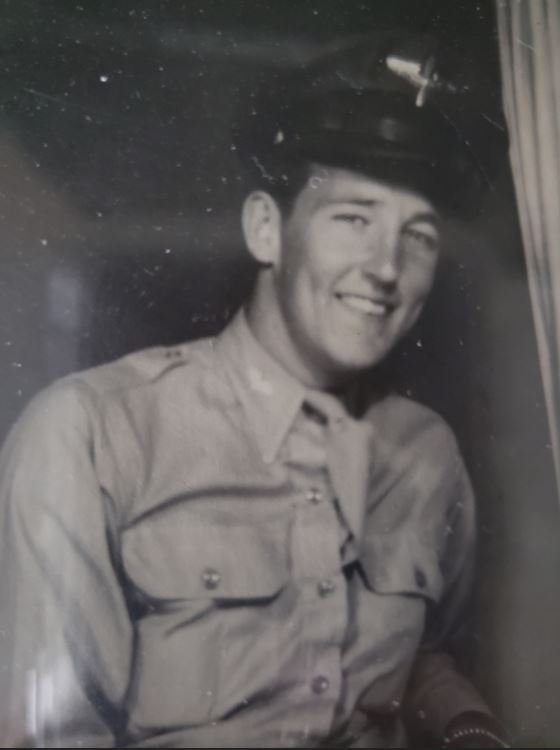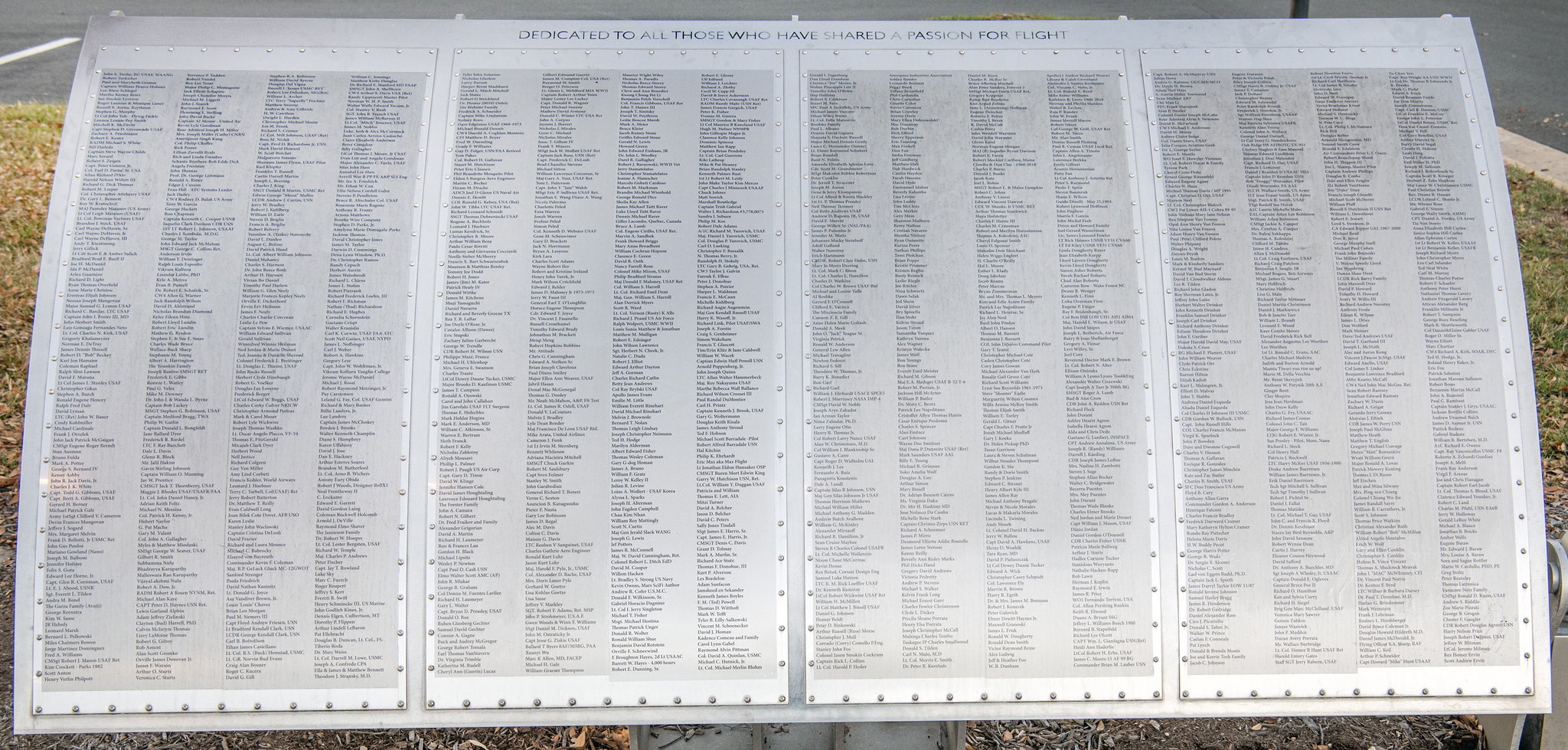James M. Taylor

Foil: 63 Panel: 1 Column: 4 Line: 38
Wall of Honor Level: Air and Space Friend
Honored by:
Sharon Taylor
Interview: James Murray Taylor
I interviewed a great American hero, who has a great story about His time serving in the United States Air-force during World War II. 1ST LT. James Murray Taylor was born in Grand Junction Tennessee; on June 23, 1922 to Murray and Lavergne Stroup Taylor. James graduated from High school and in 1940 He attended UTJC at Matin as a freshman for just that year.
On December 7,1941 Japan launched a surprise attack on the United States Naval bases of Hawaii. Which afterwards James left Martin, and went to work in Memphis, at Chicago and Southern airlines. Then He went to work for Fisher and Memphis aircraft division of General Motors, who made the floorboards of the motorized vehicles. During the war the factory produced parts for the B-25, they made engine parts and wing sections, which then would be shipped to Cleveland. While James was working there one day, a guy from Arkansas told James and Red Thomas to go and sign up for the cadets. James replied with, “What's that?” This guy explained that the cadet is where the air force gets their pilots. James and Red went and signed up, James was sworn in on September 16,1942. He was called into active service March 10,1943. James was signed to Oak Florida (Taylor Field), where He completed eleven solo hours in the PT-17 along with at least 10 hours in a P-40.
James was sent to Camp Patrick Henry (Virginia), which was a secret base during the war, He would embark from Virginia and sail to Capetown unescorted, the time spent traveling to Bombay was anywhere from 3-4 weeks. He was assigned to the 23rd fighter group; which was part of the 75th fighter squadron.
I asked James, “What made you want to be a pilot?” He said, “It was the most romantic thing in the world.” He also stated that pilot officers made 50% higher base pay then non flying officers; infantry officers earned about $150 while pilot officers made $225 a month. During the war, James served in China, where He was a member of the, “Tex Hill's Fighter Squadron, The Flying Tiger Sharks.” This group succeeded the famous, Flying Tigers. James flew the P-40 and the P-51 Mustang in combat.
During combat, James said that He only saw air-combat four to five times; the Japanese air force by this time was nearly destroyed. Most of the missions consisted of destroying ground targets such as, troops, trains, supply depots and sea vessels. James was flying in His P-40 one day, when a Japanese fighter got on His 6'o clock position when He was over Whitecloud (Japanese airfield). All American pilots were issued a “Blood Chits” or nationalist Chinese Identification paper. It was written in Chinese so that a downed American pilot would hopefully be able to return to their base. All supplies that the air force needed were flown over “The Hump,” the Himalayan Mountains. The Japanese empire held all the ports that were in China.
What would you do if you were tied to a tree, while Japanese soldiers dug your grave? Lt. James M. Taylor,Jr. “Cuss, pray and sing.” James took off in His brand new P-51 Mustang on the morning of November 11,1944,heading toward Hengyang China for a strafing run. When they reached their target, enemy fighters were spotted and James and three other Mustangs, “went down for the kill.” James went on two successful strafing runs, then decided to return, His third and final strafing run resulted in His aircraft’s engine failing, James had to bailout of His aircraft at a mere 400 feet.
After landing on the ground, James burned His chute, maps and papers, while the enemy troops were looking for Him. He hid for a bit, and then was captured; at this time the Japanese soldiers tied Him to a tree and began to dig His grave. He said, that the soldiers would dig awhile, then they would stop and rest awhile then continued this cycle until six o' clock. Taylor later said, He knew His time was coming to an end. But suddenly the soldiers untied Him, and took Him away from the grave.
Taylor had His shoes removed and was taken on a march throughout the city, barefooted. During the march an enemy officer spat in His face, James spat back; James was beaten on the ground by the officer’s sword. Later He was taken to a prison camp, where He was questioned for three days and nights before, He was untied and given a small amount of food. Two weeks later, James was transported to Hankow where He was placed in solitary confinement for two months, with just small rations as food. During these two months, He was never allowed to bathe or brush His teeth. After about two months, He was moved to Shanghai where He was with 1000 other American prisoner.
Late in May 1945; Taylor began His last journey as a prisoner of war to the Japanese homeland. James and eleven other men were shipped, by train, to the Japanese island, Hokkaido.
On August 15, the food situation changed for the better, instead of the few handfuls of rice that the men had to share, the Japanese started bringing in rice by the bucket. The next day the men received even more food, and they knew that the war was over.
The Diddled Dozen consisted of 12 men, who all had been captured and put into a room with one another over the time of the war. On May 9,1945; the entire camp began a move that would take two months, there final destination was Japan. After five days the men found themselves near boxcars, the entire camp slept in two warehouses until they were loaded up on the boxcars on June 19. They went through Manchuria, Korea and Pusan.
Next they were loaded onto a ship at nearly three am, and then made a dangerous crossing, of the Strait of Korea, which took about 1.5 days to complete. The ship unloaded the men at the northern tip of Honshu Island on June 30. The next day, they boarded a passenger train that took them on a long trip east, passing through Tokyo. James and the Diddled Dozen, headed south on another train where they arrived in Sapporo where they would remained; until they were handed to the U.S army on September 11, 1945.
During the time that the men were POW'S, they spent the majority of their time in a small room, which was guarded by a full time guard. Rations became even smaller toward the end of the war as the U.S forces closed in on the Japanese homeland. The group had one guard that was not mean, Beefu Stakee, He would chat with James with sign language and sounds. He asked once to borrow James flying gloves for a night out, the next morning the gloves were returned to James.
On August 15, the food situation changed for the better, instead of the few handfuls of rice that the men had to share, the Japanese started bringing in rice by the bucket. The next day the men received even more food, and they knew that the war was over. The weeks leading up to the end of the war, B-29 bombers would drop supplies down to the soldiers. The camp that the Diddled Dozen were in, along with many other POW'S, went four days, while expecting a loud to be dropped to their camp. On that fourth day, a B-29 dropped a note, which was tied to a red life raft sale, which was weighed down by a wrench. The note read as followed, “Hi fellows: We will be back as soon as possible with supplies. We know you need them and are doing our best. 500th Bomb Group, Major Vance E. Black”
Wall of Honor profiles are provided by the honoree or the donor who added their name to the Wall of Honor. The Museum cannot validate all facts contained in the profiles.
Foil: 63
All foil images coming soon.View other foils on our Wall of Honor Flickr Gallery
